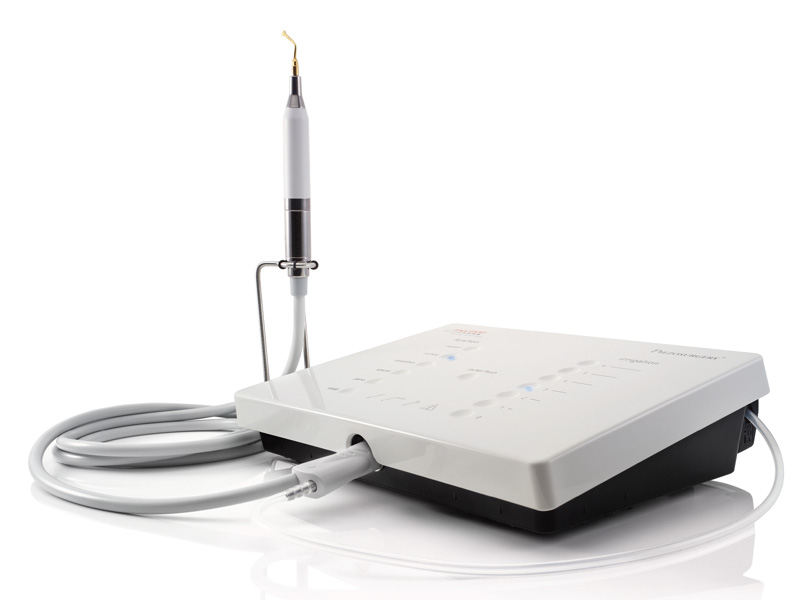Dental Technologies
Mectron Piezosurgery – Working | Comparison | Advantages | Application

Piezosurgery is a New Frontier in Dental Surgery. It is a new bone cutting technique that involves the use of ultrasonic waves — now becoming standard in the dental office. An increasing number of dentist and surgeons are adopting the method, as they find it harmless and safer and less invasive than traditional motorized or manual approaches.
Piezosurgery is a handheld device that generates ultrasonic micro-vibrations to safely and precisely leaving soft tissues untouched, cuts through bone with impressive precision avoiding soft tissue altogether. It is being used in dental applications, including oral surgery, periodontics, and implantology.
Piezoelectricity is a fascinating form of electrical energy. It generates when crystals, such as quartz, are “pressed” or subjected to mechanical stress. As an effect, electricity flows. The crystal has a positive charge and a negative charge. When two faces are connected, the current flows to create an electrical circuit. The energy produced by this piezoelectric effect is harnessed. Then the device called a piezoelectric transducer turns into other forms of energy, such as ultrasound. These ultrasonic waves can then be increased and converted into faster-automated vibrations. The devise tip vibrates within a range of 60–200mm, which enables the dentist to cut through bone cleanly with high precision while the handpiece is fortified with a sterile irrigation system. An LED light for thoroughgoing visibility and safety is also there. The power emitted from the ultrasound could be adjusted according to different types of bone density.
Three Main Modes of Piezosurgery:
For root canal treatments, low mode is the most appropriate.
High mode is used for cleaning and smoothing out bone borders.
The boosted mode is often used in oral and maxillofacial surgery for osteoplasty and osteotomy procedures
Is Piezosurgery Better Than Traditional Bone Cutting Methods?
Dental surgery traditionally with manual cutting devices involves manipulation or reshaping of the bone, which is performed by manual instruments like the bone chisels and other tools like the rongeurs. Sometimes powered rotary instruments like the rotary burs and oscillating saws are also used. Manual cutting devices usually are used for rough-cutting more significant segments of bone which are more challenging to control when precision is necessary. They can cause microfractures and damage the bone or surrounding soft tissue. Postoperative inflammation and bleeding may occur, and this can slow down healing, this can be stressful for the patient
Piezosurgery represents a significant improvement than the techniques mentioned above.
Piezoelectric devices are ultrasonic device that aids the micrometric cutting of bone and greater precision with no bone loss. It is unusually light and easy to handle and to cut across a flat plane or in a curvilinear fashion from side to side. The surrounding soft tissue remains intact and no bleeding, which in turn improves visibility of the operation site. Less collateral tissue damage and bleeding also mean not as much swelling. Ultrasonic vibrations benefit stimulating cellular metabolism. The absence of dead tissue in the cut area accelerates bone regeneration. The device produces significantly less noise than motorized equipment and requires no applied pressure, reducing psychological fear and distress to the patients.
Piezosurgery was made to meet the demand for better safety, well-being, and exactness in the bone surgical procedure. Piezosurgery minimizes any pain to the blood vessels, nerves, and membranes.
- The cut bone regenerates more quickly.
- Visibility of the operational area is improved due to a blood-free surgical site.
- Piezosurgery involves reduced hand pressure. Operator sensitivity and control is, therefore, more relaxed so that the dentist can develop an improved sensation for the micro-vibrations then generates the cutting of the bone.
- Piezo-surgical devices do not heat with use, no danger of loss to the neighboring tissue.
- Patients generally experience reduced traumatic stress during processes
- Piezosurgery allows bone cutting with maximum exactness.
- Flat cuts and curvilinear cuts are possible with Piezosurgery.
- Less inflammation during and after the surgery.
- The patient experiences minimal surgical pain and rapid postoperative healing
Piezosurgery is useful and can be applied in a wide range of procedures in which delicacy and precision essential. It is used in enabling bone surgery in anatomically complex situations. Also widely used in oral surgery, periodontics, and implantology
- Cystectomy
- Root extraction
- Sinus lift
- Apicoectomy
- Preparation of root canal
- Soft tissue debridement treatment (the tip of the device can be changed and power setting altered to get rid of residual soft tissue and calculus)
- Wisdom tooth extraction
- Bone splitting
- Root canal retreatment (broken files retrieval)
- Implantology
- Ridge expansion
- Bone harvesting for bone grafts
- Implant site preparation
- Implant removal
- Crown lengthening
- Periodontology
- Root debridement
- Root planning
- Osteotomy
- Osteoplasty
- Reconstructive operations
The final word
Piezosurgery is a relatively novel technique of bone surgery that is of late gained popularity in implantology, periodontics, and oral surgery. Piezosurgery improves the patient experience. Standard processes such as preparation of a root canal or impacted wisdom tooth extraction are made considerably less threatening when Piezosurgery is opted, in place of traditional bone cutting methods. Healing time and post-operative uneasiness is reduced drastically. If you are due to undergo a periodontal procedure, ask your dentist about Piezosurgery.
References: https://www.malidds.com/piezosurgery-working-comparison-advantages-application/
